 Web Front-end
Web Front-end
 PS Tutorial
PS Tutorial
 Learn PS with me Day 3 01: Get to know the Photoshop toolbox (Part 1)
Learn PS with me Day 3 01: Get to know the Photoshop toolbox (Part 1)
Learn PS with me Day 3 01: Get to know the Photoshop toolbox (Part 1)
Learn PS with me
Day 01: Understanding the Photoshop toolbox (Part 1)
After starting the Photoshop software, the toolbox It will appear on the far left side of the panel, and you can also show or hide the toolbar through "Window - Tools". The version I use is Photoshop CC, which contains more than 70 tools in the toolbox. Next, we will introduce them to you one by one.
Toolboxes are mainly divided into the following four categories according to their functions and characteristics.
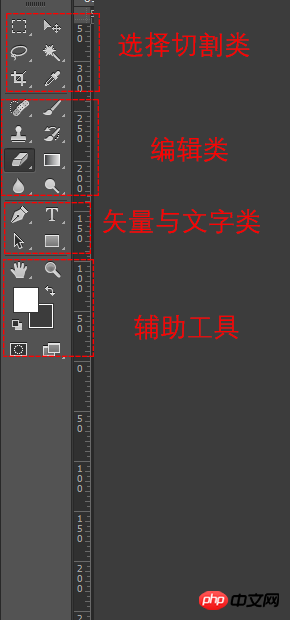
The first category: selection and cutting category
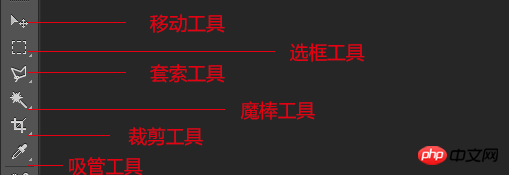
Move Tool: Used to move selections, guides and layers
Marquee Tool: Can create rectangular, elliptical, single row and single column selections.

Rectangular Marquee Tool: Make a rectangular selection range for the image, generally used to create rectangles and rectangular marquees
Elliptical Marquee Tool: Select a circular selection range for the image, generally used to create circles and circular marquees
Single-line Marquee Tool: Select one row of the image in the horizontal direction Pixels, generally used for more subtle selections
Single column marquee tool: Select a row of pixels in the vertical direction of the image, generally used for more subtle selections
Lasso tool:Can create hand-drawn, polygonal, and magnetic selections, mostly used for picking out pictures that are not very demanding.
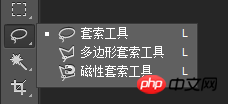
Lasso Tool: Hold down the mouse and drag it to make an irregular selection range, generally used for less demanding selections
Polygonal Lasso Tool: Now set a point on the image and draw it. Note that the points between points are composed of straight lines. Arc selections cannot be drawn. It is generally suitable for outlining images without arcs.
Magnetic Lasso Tool: This tool is similar to magnetism. You don’t need to click the mouse. If you move the mouse, it will automatically track and connect end to end to automatically form a selection. It should be noted that this "magnetic line" only appears at the boundary where the color is different. The greater the color difference, the more obvious the magnetism. It is generally used on images with large color differences.
Magic Wand Tool: You can select selections with the same or similar colors
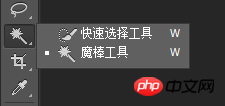
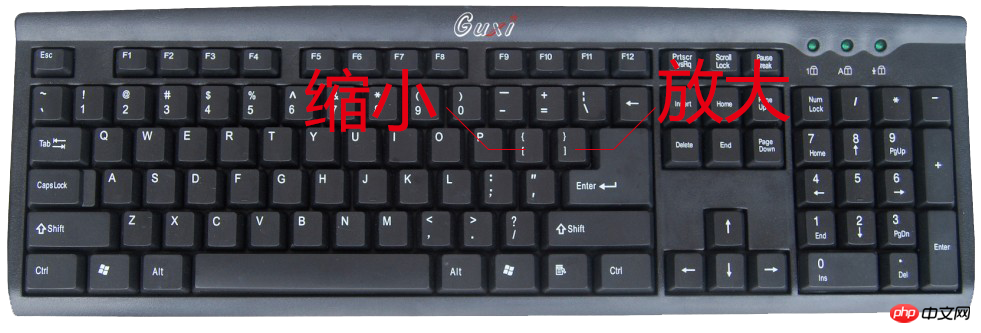
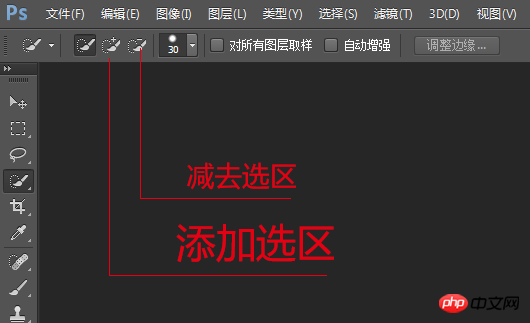

Cropping tool: Used to crop images at corresponding proportions. Drag the mouse to reduce and expand nodes. Double-click or press the Enter key. End clipping.
The eyedropper tool: It is mainly used to absorb a certain color on the image and turn it into the foreground color. You can absorb it with one click.
Second category: Editing category
Healing Brush Tool: Use the pattern in the sample to repair imperfect parts of the selected area, such as removing stains, etc. It is mostly used to modify some small flaws.

#Brush Tool: Mainly used to color images Right click the mouse and the following selection box will pop up Control the coloring pressure by adjusting the size and hardness. The following are the types of brush patterns, which we will talk about in the future. Looking at the toolbar again, opacity and flow are also important colors that determine coloring. Among them, opacity is used the most. Stamp Tool: Draws an image using a copy of the source image. Partial copy to achieve the effect of repairing the image. Clone Stamp Tool: Mainly used for parts of the image. When repairing, first hold down the Alt key, move the mouse to the sampling point, click the left button to select the pattern that needs to be repaired, then drag the mouse to the place that needs to be repaired, and click again. Pattern Stamp Tool: It is also used to copy images. But the difference is that we preset the pattern we need and then apply it. Next, let's look at an example Click the mouse on the place we want to repair, and the picture will be as follows
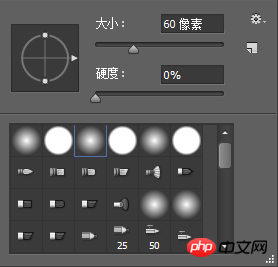

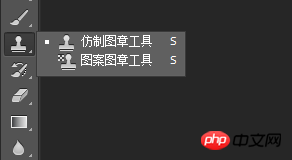
 We use the pattern stamp tool to copy. First, click the rectangular selection tool, select a pattern that needs to be copied, and then click "Edit-Define Pattern" , name it "Flower", then click the Pattern Stamp Tool, and then select the pattern we just set on the toolbar.
We use the pattern stamp tool to copy. First, click the rectangular selection tool, select a pattern that needs to be copied, and then click "Edit-Define Pattern" , name it "Flower", then click the Pattern Stamp Tool, and then select the pattern we just set on the toolbar. 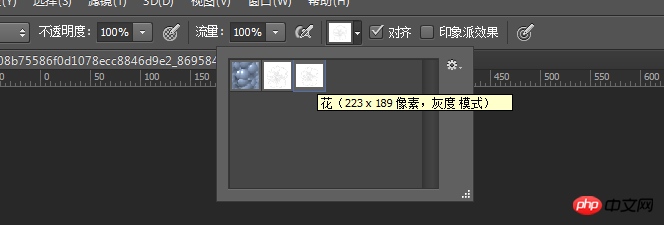

The above is the detailed content of Learn PS with me Day 3 01: Get to know the Photoshop toolbox (Part 1). For more information, please follow other related articles on the PHP Chinese website!

Hot AI Tools

Undresser.AI Undress
AI-powered app for creating realistic nude photos

AI Clothes Remover
Online AI tool for removing clothes from photos.

Undress AI Tool
Undress images for free

Clothoff.io
AI clothes remover

AI Hentai Generator
Generate AI Hentai for free.

Hot Article

Hot Tools

Notepad++7.3.1
Easy-to-use and free code editor

SublimeText3 Chinese version
Chinese version, very easy to use

Zend Studio 13.0.1
Powerful PHP integrated development environment

Dreamweaver CS6
Visual web development tools

SublimeText3 Mac version
God-level code editing software (SublimeText3)

Hot Topics
 1382
1382
 52
52
 ps serial number cs5 permanently free 2020
Jul 13, 2023 am 10:06 AM
ps serial number cs5 permanently free 2020
Jul 13, 2023 am 10:06 AM
PS serial numbers cs5 permanent free 2020 include: 1. 1330-1384-7388-4265-2355-8589 (Chinese); 2. 1330-1409-7892-5799-0412-7680 (Chinese); 3. 1330-1616-1993 -8375-9492-6951 (Chinese); 4. 1330-1971-2669-5043-0398-7801 (Chinese), etc.
 What to do if ps installation cannot write registry value error 160
Mar 22, 2023 pm 02:33 PM
What to do if ps installation cannot write registry value error 160
Mar 22, 2023 pm 02:33 PM
Solution to error 160 when ps installation cannot write registry value: 1. Check whether there is 2345 software on the computer, and if so, uninstall the software; 2. Press "Win+R" and enter "Regedit" to open the system registry, and then Find "Photoshop.exe" and delete the Photoshop item.
 How to delete selected area in ps
Aug 07, 2023 pm 01:46 PM
How to delete selected area in ps
Aug 07, 2023 pm 01:46 PM
Steps to delete the selected area in PS: 1. Open the picture you want to edit; 2. Use the appropriate tool to create a selection; 3. You can use a variety of methods to delete the content in the selection, use the "Delete" key, use the "Healing Brush Tool" , use "Content-Aware Fill", use the "Stamp Tool", etc.; 4. Use tools to repair any obvious traces or defects to make the picture look more natural; 5. After completing editing, click "File" > in the menu bar "Save" to save the editing results.
 Introduction to the process of extracting line drawings in PS
Apr 01, 2024 pm 12:51 PM
Introduction to the process of extracting line drawings in PS
Apr 01, 2024 pm 12:51 PM
1. Open the software and import a piece of material, as shown in the picture below. 2. Then ctrl+shift+u to remove color. 3. Then press ctrl+J to copy the layer. 4. Then reverse ctrl+I, and then set the layer blending mode to Color Dodge. 5. Click Filter--Others--Minimum. 6. In the pop-up dialog box, set the radius to 2 and click OK. 7. Finally, you can see the line draft extracted.
 What should I do if the PS interface font is too small?
Dec 01, 2022 am 11:31 AM
What should I do if the PS interface font is too small?
Dec 01, 2022 am 11:31 AM
How to fix the PS interface font that is too small: 1. Open PS, click the "Edit" button on the top menu bar of PS to expand the editing menu; 2. Click the "Preferences" button in the expanded editing menu, and then click "Interface. .." button; 3. In the interface settings, set the user interface font size to "Large", set the UI scaling to "200%" and save the settings, then restart PS to take effect.
 How to automate tasks using PowerShell
Feb 20, 2024 pm 01:51 PM
How to automate tasks using PowerShell
Feb 20, 2024 pm 01:51 PM
If you are an IT administrator or technology expert, you must be aware of the importance of automation. Especially for Windows users, Microsoft PowerShell is one of the best automation tools. Microsoft offers a variety of tools for your automation needs, without the need to install third-party applications. This guide will detail how to leverage PowerShell to automate tasks. What is a PowerShell script? If you have experience using PowerShell, you may have used commands to configure your operating system. A script is a collection of these commands in a .ps1 file. .ps1 files contain scripts executed by PowerShell, such as basic Get-Help
 Complete list of ps shortcut keys
Mar 11, 2024 pm 04:31 PM
Complete list of ps shortcut keys
Mar 11, 2024 pm 04:31 PM
1. Ctrl + N: Create a new document. 2. Ctrl + O: Open a file. 3. Ctrl + S: Save the current file. 4. Ctrl + Shift + S: Save as. 5. Ctrl + W: Close the current document. 6. Ctrl + Q: Exit Photoshop. 7. Ctrl + Z: Undo. 8. Ctrl + Y: Redo. 9. Ctrl + X: Cut the selected content. 10. Ctrl + C: Copy the selected content.
 What is the ps curve shortcut key?
Aug 22, 2023 am 10:44 AM
What is the ps curve shortcut key?
Aug 22, 2023 am 10:44 AM
The ps curve shortcut key is Ctrl+M. Other curve shortcut keys: 1. Convert to point control curve, Alt+Shift+Ctrl+T; 2. Automatically align the curve, Alt+Shift+Ctrl+O; 3. Restore the default curve, Ctrl+Alt+Shift+R; 4. Copy the curve, Ctrl+Alt+Shift+C; 5. Paste the curve, Ctrl+Alt+Shift+V; 6. Adjust the curve slope, Shift+up and down arrows; 7. Adjust the curve brightness, Shift+left and right arrows



